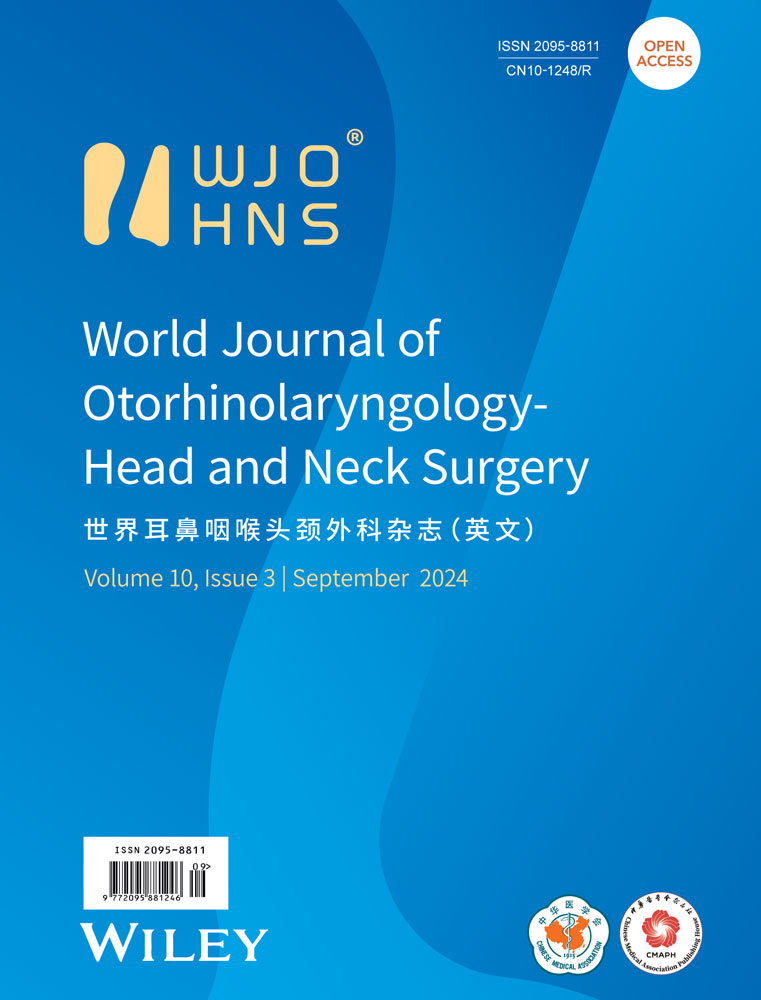Papillary thyroid carcinoma: A bibliometric analysis of the top 100 cited articles
Abstract
Objectives
To describe the current trends and key themes that are shaping the literature surrounding papillary thyroid carcinoma.
Methods
The Thomson Reuters Web of Science citation database was used to identify manuscripts relevant to papillary thyroid carcinoma. These were then subdivided into title, author, journal, publication date, theme, and manuscript types. Themes were then identified.
Results
A total of 1506 manuscripts were returned. The mean citation number was 163 (range 885–74), with the highest citation rate of 73.5. The highest impact factor was JAMA (impact factor of 56.27). 85% were original research, 10% review articles, and 5% were guidelines. The highest number of manuscripts were published in South Korea (21%).
Conclusions
This bibliometric analysis describes the most influential papers published in the topic of papillary thyroid carcinoma. Historic key themes have been endocrinology and metabolism, followed by surgical management and oncology (subdivided into surgery, pathology, radiology and public health/epidemiology). South Korea leads the world with the largest number of publications in this field; with an incidence rate of papillary thyroid carcinoma that is significantly higher than most parts of the world. Despite concerns with overdiagnosis, a collaborative radiological team skilled in ultrasonography of the neck appears to be of great value to the workup of thyroid cancers.
Key points
-
Thyroid carcinoma is a global phenomenon affecting the global population.
-
Mortality rates were 0.5 per 100,000 in women and 0.3 per 100,000 in men.
-
Treatment for papillary thyroid carcinoma tends to begin with ultrasonography and fine needle aspiration cytology (FNAC) to diagnose and confirm malignancy.
-
Due to the large and increasing incidence of papillary thyroid carcinoma worldwide, a large body of literature exists discussing various topics, including its surgical management, radiological identification and epidemiological prevalence.
-
The following bibliometric analysis is aimed at describing the current trends and key themes that are shaping the literature surrounding papillary thyroid carcinoma; including its identification, management and epidemiology.
-
A total of 1506 manuscripts were returned from the Web of Science Core Collection.
-
The most cited paper was “Risk of malignancy in nonpalpable thyroid nodules: Predictive value of ultrasound and color-Doppler features” by Papini et al.
-
The manuscript with the highest citation rate is “Ultrasonography Diagnosis and Imaging-Based Management of Thyroid Nodules: Revised Korean Society of Thyroid Radiology Consensus Statement and Recommendations” by Shin et al.
-
The oldest paper in the top cited papers was “Papillary thyroid microcarcinoma—a study of 535 cases observed in a 50-year period” by Hay et al.
-
The most recent manuscript was “US Fine-Needle Aspiration Biopsy for Thyroid Malignancy: Diagnostic Performance of Seven Society Guidelines Applied to 2000 Thyroid Nodules” by Ha et al., published in the journal “Radiology” in 2018.
-
The largest number of manuscripts were published in the journal “Thyroid,” with an impact factor of 6.57.
-
In this search, the highest number of manuscripts were from South Korea (21%, n = 21), followed by joint second from Italy and the United States (19%, n = 19).
INTRODUCTION
Thyroid carcinoma is a global phenomenon affecting the global population. According to the GLOBOCAN epidemiological study in 2020, the age-standardized incidence rates of thyroid cancer were 10.1 per 100,000 women and 3.1 per 100,000 in men. Mortality rates were 0.5 per 100,000 in women and 0.3 per 100,000 in men.1
The incidence of thyroid cancer has been on the rise for the last several decades.2 This is partly due to the advances in thyroid ultrasound and its identification of microcarcinomas, which are lesions too small to be palpated and partly due to higher rates of aggressive disease with distant metastases.3 The incidence of thyroid cancer seems to be significantly higher in countries with a higher Human Development Index (HDI),4 raising the question of potential overdiagnosis due to efficient screening services in these countries.5 Papillary thyroid carcinoma (PTC) is the most common of the thyroid cancers, making up 80%–85% of thyroid cancers.
Treatment for PTC tends to begin with ultrasonography and fine needle aspiration cytology (FNAC) to diagnose and confirm malignancy.6 PTC is traditionally treated with surgery. The extent of surgical resection is dependent on the size of the carcinoma. Due to the multifocal nature of papillary thyroid cancer, the two main current options are total thyroidectomy or hemithyroidectomy (or lobectomy + isthmusectomy). However, no level one evidence exists to clearly demonstrate the benefit of one over the other.7, 8
Due to the large and increasing incidence of PTC worldwide, a large body of literature exists discussing various topics, including its surgical management, radiological identification and epidemiological prevalence. As such, it can be difficult to identify manuscripts and key themes that have the most relevance and therefore clinical significance. A citation is received by a manuscript when it is referenced by another peer-reviewed article. A list of the most cited/influential articles can therefore be constructed by ranking such articles by the number of citations it has achieved. A bibliometric analysis can then be used to identify and stratify high-ranking manuscripts with subdivisions such as citation rank, impact factor of journal and citation rate per year. This will demonstrate areas where high-quality research has been undertaken, and areas where research is lacking. These methods have been used in multiple surgical fields such as orthopedics, general surgery and urology.9-11
The following bibliometric analysis is aimed at describing the current trends and key themes that are shaping the literature surrounding PTC; including its identification, management and epidemiology.
MATERIAL AND METHODS
The Thomson Reuters Web of Science citation database was interrogated using methods previously published.12, 13 Due to the broad relevance of thyroid disease (pathology, epidemiology, and malignancy) to various medical and surgical specialities, it was important to ensure that appropriate search terms were used to determine relevant manuscripts pertaining to PTC. The following search terms were used: “papillary thyroid cancer,” or “PTC,” or “papillary thyroid microcarcinoma.”
Upon completion, a final interrogation of the database was performed independently by two assessors (Mahamud Ishtiak and Ahmed Jake). The manuscripts were subdivided into title, first and senior author, journal, publication date, country of origin, theme, and manuscript type. All papers were limited to the English language, with all papers published historically included in the search. Due to subdivisions of thyroid carcinoma, mentions of follicular, medullary, and anaplastic were strictly removed following independent agreement between the two assessors.
A further subdivision of citation rate was applied to the database; this is achieved by dividing the number of citations by the number of years since the manuscript was initially published. This method, described and validated in, is a tool used to counter biases achieved by older publications to have larger numbers of citations over a longer period.9, 12, 13 Thomson Reuters Journal Citation Reports (JCR) was then used to identify the 2020 impact factor of each journal.14
RESULTS
A database search was conducted on March 15, 2022 using the Thomson Reuters Web of Science database. A total of 1506 manuscripts were returned from the Web of Science Core Collection. Supporting Information: Table S1 displays the top 100 cited articles as described in Materials and Methods. Citation rate was also used to add additional stratification with papers with the same number of citations.
The mean number of citations in this collection was 163, with a range between 885 and 74. The most cited paper was “Risk of malignancy in nonpalpable thyroid nodules: Predictive value of ultrasound and color-Doppler features” by Papini et al. This was published in 2002 in the Journal of Clinical Endocrinology and Metabolism and has received a total of 885 citations. This was a radiological study aimed at correlating ultrasound-guided fine needle aspiration biopsies with ultrasound and color-doppler findings in a sample of 494 patients (Table 1).15
As mentioned in Materials and Methods, citation rate is a validated tool used to eliminate bias of older papers having higher numbers of citations over time. The manuscript with the highest citation rate is “Ultrasonography Diagnosis and Imaging-Based Management of Thyroid Nodules: Revised Korean Society of Thyroid Radiology Consensus Statement and Recommendations” by Shin et al. (Supporting Information: Table S1). This guideline/recommendation for ultrasound diagnosis and management of thyroid nodules was published in the Korean Journal of Radiology in 2016, with a total citation number of 441 and with a citation rate of 73.5.16 The paper that ranked second in citation rate was “Patient Age Is Significantly Related to the Progression of Papillary Microcarcinoma of the Thyroid Under Observation” by Ito et al. published in the journal “Thyroid” in 2014, and has a total number of citations of 416 and a citation rate of 52.17
Although all historically published papers regarding PTC were included in the search, the earliest paper in the top 100 cited papers was in 1992. The oldest paper in the top cited papers was “Papillary thyroid microcarcinoma—a study of 535 cases observed in a 50-year period” by Hay et al. This was published in the journal “Surgery” and was an observational study of postoperative follow-up for patients characterized with papillary thyroid microcarcinoma (Supporting Information: Table S1).18 The most recent manuscript was “US Fine-Needle Aspiration Biopsy for Thyroid Malignancy: Diagnostic Performance of Seven Society Guidelines Applied to 2000 Thyroid Nodules” by Ha et al., published in the journal “Radiology” in 2018. This 2000 patient study was aimed at comparing ultrasound guided biopsy diagnosis with the diagnostic criteria from seven international society criteria.19
The largest number of manuscripts were published in the journal “Thyroid,” with an impact factor of 6.57. The journal with the highest citation rate that is included in this search was “JAMA” (Journal of the American Medical Association), with an impact factor of 56.27 (Figure 1).
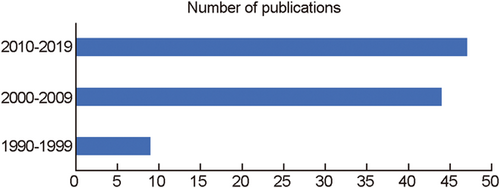
The manuscripts were subdivided into manuscript types. 85% (n = 85) were original research papers, 10% (n = 10) were review articles and 5% (n = 5) were guidelines (Figure 2). The 85 original research papers were then subdivided into study types. The most common subtype was a clinical interventional study (35%, n = 30), followed by papillary thyroid biochemical research (27%, n = 23). The remainder was divided between epidemiological studies, histology, radiology and clinical observational studies (Figure 3). All manuscripts have an associated Web of Science research category, assigned by the citation database. The most common topic was Endocrinology and metabolism (37%, n = 37) followed by surgery (24%, n = 24).
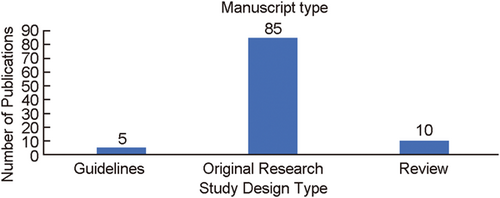
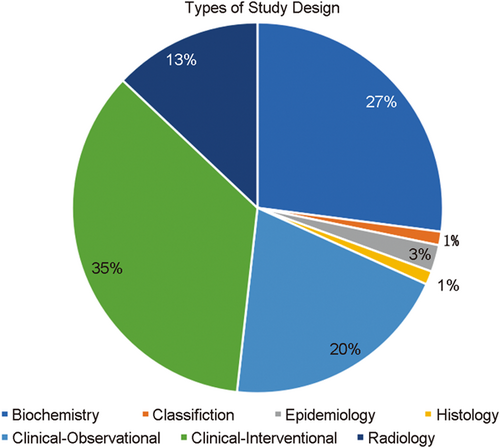
Thyroid research is of global importance; therefore, manuscripts have been published from international sources. In this search, the highest number of manuscripts were from South Korea (21%, n = 21), followed by joint second from Italy and the United States (19%, n = 19).
DISCUSSION
This manuscript is a bibliometric analysis of the top 100 cited articles describing PTC. The focus is to ascertain the number of citations for each paper and rank them from highest to lowest, as well as other important subdivisions such as citation rate, age, methodology and geographic location. The most cited article was “Risk of malignancy in nonpalpable thyroid nodules: Predictive value of ultrasound and color-Doppler features” by Papini et al., published in 2002 in the “Journal of Clinical Endocrinology and Metabolism.”15 This study of 494 consecutive patients was done to establish the importance of ultrasound features as risk factors to malignancy as the most cost-effective way to manage nonpalpable thyroid nodules. All patients in this study with adequate cytology (after evaluation with ultrasound, color-doppler and ultrasound FNA) were divided into suspicious/malignant cytology and benign cytology. Those with malignant cytology underwent surgical resection, whilst those with benign cytology had clinical/ultrasound follow-up 6 months later. Cancer prevalence did not differ largely between lesions below and above 10 mm, with no statistical difference in prevalence of extracapsular growth and nodal involvement between these two groups. At ultrasound examination, most cancers presented as solid hypoechoic lesions in 87% of cases. It was concluded that fine needle aspiration performed on all solid hypoechoic lesions with an independent risk factor for malignancy (irregular margins, intranodal vascular spots, and microcalcifications) could identify 87% of cancers and was concluded that US-FNA should be performed in all 8–15 mm hypoechoic nodules with at least one of the independent risk factors of malignancy. Nonpalpable lesions with no risk factors of malignancy can be followed up clinically and with ultrasound evaluation.
The second most cited manuscript was “Papillary microcarcinoma of the thyroid—Prognostic significance of lymph node metastasis and multifocality” by Chow et al., published in the journal “Cancer” in 2003. It achieved 514 citations in the Web of Science Core Collection database. This original research paper aimed to identify prognostic factors and formulate treatment plans for those patients with Papillary microcarcinoma of the thyroid (PMC). There is some discussion regarding overtreatment of such lesions as they tend to have a very favorable prognosis. This study found that although this diagnosis did carry excellent 10-year survival rates, there was still a 1% disease mortality rate, a 5% lymph node recurrence rate and a 2.5% distance metastasis rate. As such, PMCs should be treated the same as patients with PTC, in terms of both surgical management as well as radiotherapy as required.
The paper with the highest citation rate is “Ultrasonography Diagnosis and Imaging-Based Management of Thyroid Nodules: Revised Korean Society of Thyroid Radiology Consensus Statement and Recommendations” published in the “Korean Journal of Radiology” in 2016. With a citation rate of 73.5, it stands well above the next competitor (“Patient Age Is Significantly Related to the Progression of Papillary Microcarcinoma of the Thyroid Under Observation,” published in “Thyroid,” 2014, with a citation rate of 52). This review and recommendation manuscript is an expert consensus combined with analysis of the current literature surrounding ultrasound diagnosis of thyroid nodules and their management. This is an update to recommendations previously published by the Korean Society of Thyroid Radiology (KSThR) in 2011. The update was required due to the recent increased emphasis on ultrasound diagnosis and management for thyroid nodules in the current literature and practice. It is reasonable therefore that this paper would have the highest citation rate, due to the fact that it has updated recommendations from an already well-established manuscript as well as being from South Korea, which has the highest number of manuscripts in the top 100 most cited by geographic location (Figure 2).
Despite being a topic with international relevance, the top 100 cited manuscripts are dominated by papers from South Korea (21%, n = 21), followed by joint second place from the United States and Italy (19%, n = 19). Japan and China contribute 15% and 10%, respectively. In other bibliometric analyses (citation) the United States seems to lead in academic dominance; largely as a reflection of historically high levels of funding for research in the United States. This trend is broken, however, in the theme of PTC. This may be due to an increased incidence of thyroid cancer in South Korea; in 2012 this was estimated at 58.3 per 100,000, which is 15 times higher than the United Kingdom and 5.6 times higher than the United States. With no significant dietary differences, nuclear activity or genetic predisposition to thyroid cancer to account for this increase, it may be due to a strong national screening program for thyroid cancer, potentially leading to overdiagnosis and treatment. South Korea also has the highest incidence to mortality rate ratio in both sexes, according to GLOBOCAN epidemiological study 2020.1
The impact factor rating of a journal is traditionally used to measure its distribution and therefore the size of its audience. With the broad relevance of thyroid carcinoma to multiple medical and surgical specialties (surgery, radiology, oncology and endocrinology) publications in a broad variety of journals are expected. High-impact factor journals such as JAMA (Journal of the American Medical Association) and the Lancet boast high impact factors compared to many other journals (56.27 and 20.05 respectively, as per Journal Citation Report [JCR] 2020). It is surprising, therefore, that 89% of manuscripts in this search were in journals with an impact factor of below 10. The most frequently cited journal was the journal “Thyroid,” with an impact factor of 6.57 as per JCR 2020 (n = 16). The journal with the highest impact factor (JAMA, impact factor 56.27) appeared three times in the top 100 cited articles, making up 75% of the journals with an impact factor of >40 (Figure 4).
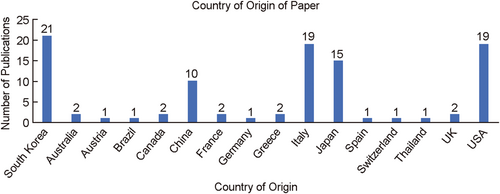
Bibliometric analyses aid in the identification of research themes and methodologies in a given subject area, both current and historic. Although a well-regarded tool, these analyses can be limited by bias. The most common bias, time bias, affects the number of citations a manuscript has. It is only natural that the longer a paper has been in circulation, the longer it will have to acquire more citations and therefore have a higher impact on the literature. The use of citation rates to further subdivide manuscripts helps to mitigate this bias, providing a more meaningful analysis of the results. As the search was conducted through the published titles of manuscripts, some may have been missed if the wording of their respective titles did not match the specific search terms of the database search. The assessors took special care to avoid contamination of the data search with papers describing other forms of thyroid cancers, including medullary and follicular, therefore the search terms were specified as described in Materials and Methods. Institutional bias may also play a role in publication imbalance. With large cohort studies/trials (e.g., large retrospective epidemiological studies), multiple studies and publications may arise from interrogating a single data set, often by the same group of authors.
CONCLUSIONS
In conclusion, this bibliometric analysis describes the most influential papers published in the topic of PTC. Historic key themes have been endocrinology and metabolism, followed by surgical management and oncology (subdivided into surgery, pathology, radiology, and public health/epidemiology). Most of the research articles were original research papers. PTC is mainly treated by either surgical management or observation with ultrasound, and therefore there are no highly cited papers in the field of medical or pharmacological management. South Korea leads the world with the largest number of publications in this field; with an incidence rate of PTC that is significantly higher than most parts of the world. As described in the results, this may be due to an effective national screening process and advanced ultrasound surveillance techniques. There has been discussion regarding this causing an overdiagnosis of PTC; further research may in fact conclude to take a more conservative approach to its management.
AUTHOR CONTRIBUTIONS
Mahamud Ishtiak: Study design; data collection; research; manuscript writing; editing. Ahmed Jake: Study design; research; manuscript writing; editing. deCastro Francis: Editing; proofreading. Sanu Ameeth: Editing; supervision.
ACKNOWLEDGMENTS
None.
CONFLICT OF INTEREST STATEMENT
The authors declare no conflict of interest.
ETHICS STATEMENT
Given the deidentified and publicly available nature of this database, this study was exempt from Institutional Review Board approval.
Open Research
DATA AVAILABILITY STATEMENT
The data that support the findings of this study are openly available in Healthgrades, WebMD, Vitals, RateMDs, Health US News, and Google Reviews.



